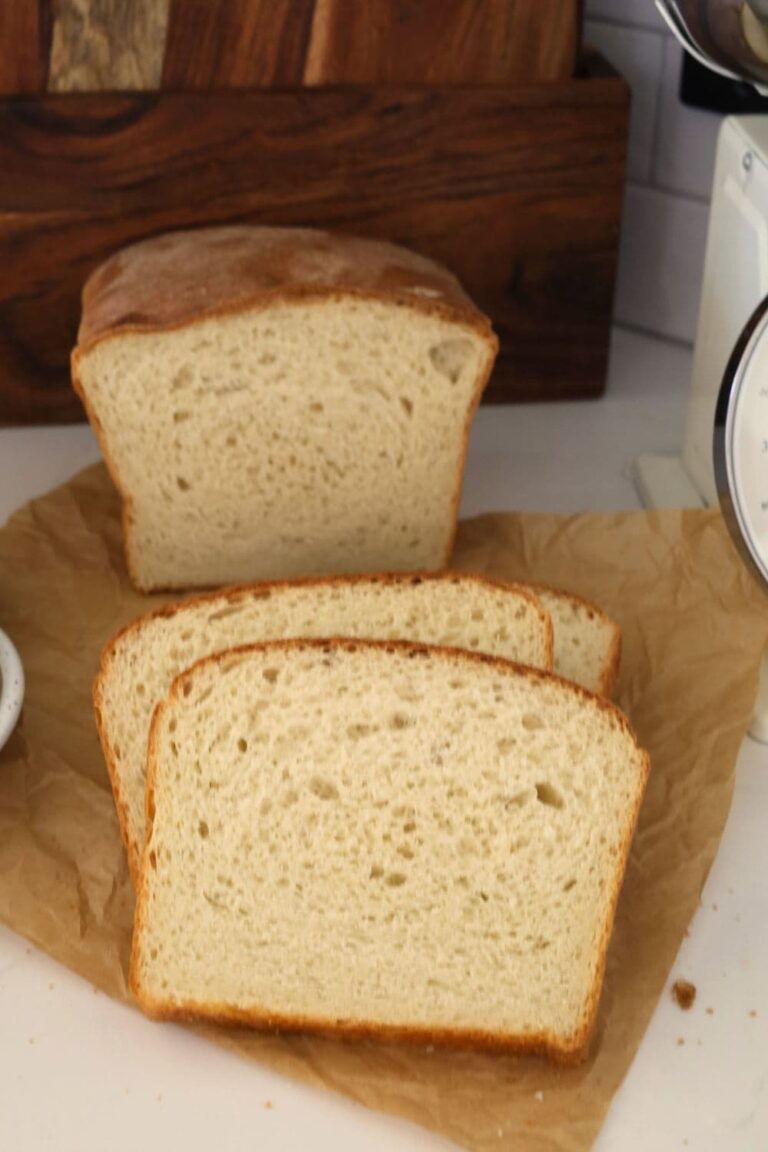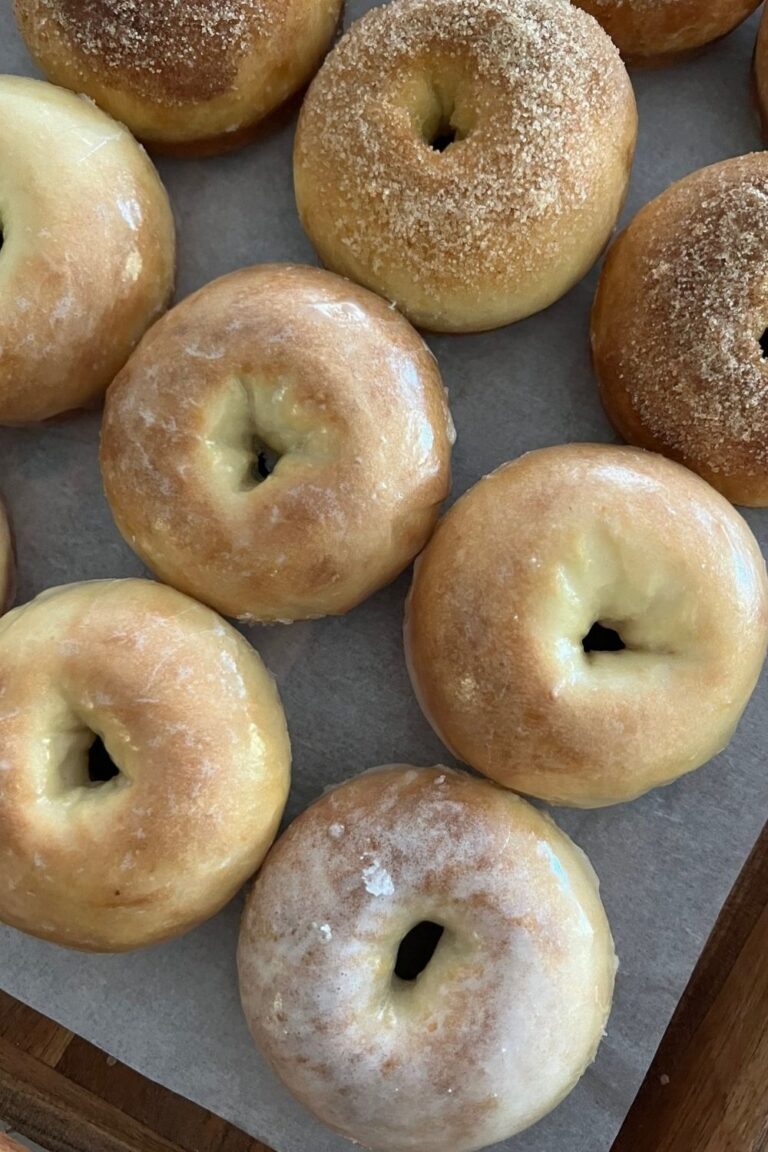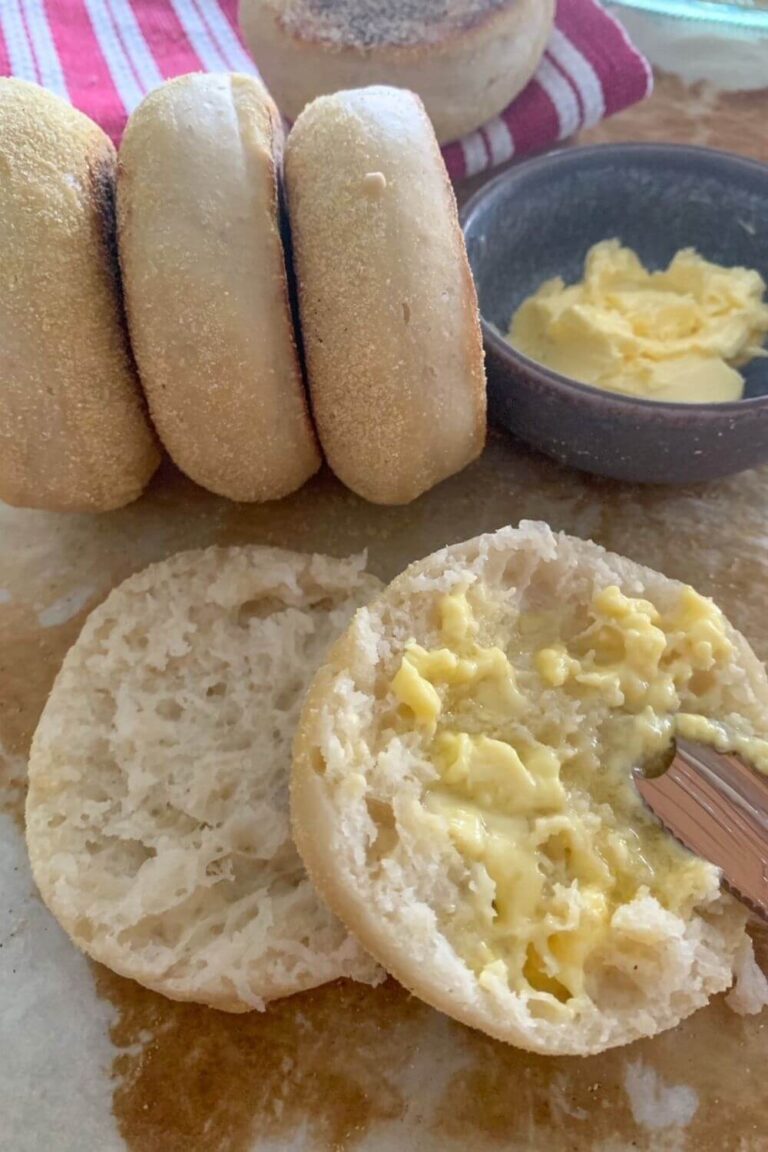Small Batch Sourdough Bread
This post may contain affiliate links.
This small batch sourdough bread is perfect if you're looking for a smaller loaf of sourdough that uses less flour, is easier to handle and is suitable for just 1 or 2 people.
This small batch sourdough recipe is less wasteful than baking a larger loaf and provides an opportunity for practicing techniques on a smaller loaf that uses less flour. Despite it's smaller size, it has a great sour flavor, light, open crumb and a crispy crust - just like you're favorite loaf!
Just like making a larger sourdough loaf, you'll need a mature sourdough starter that's been fed recently for this small batch sourdough bread recipe. I recommend using high protein bread flour for this small loaf sourdough rather than all purpose flour. You can add some whole wheat flour if you wish and I've put instructions for this further down the post.
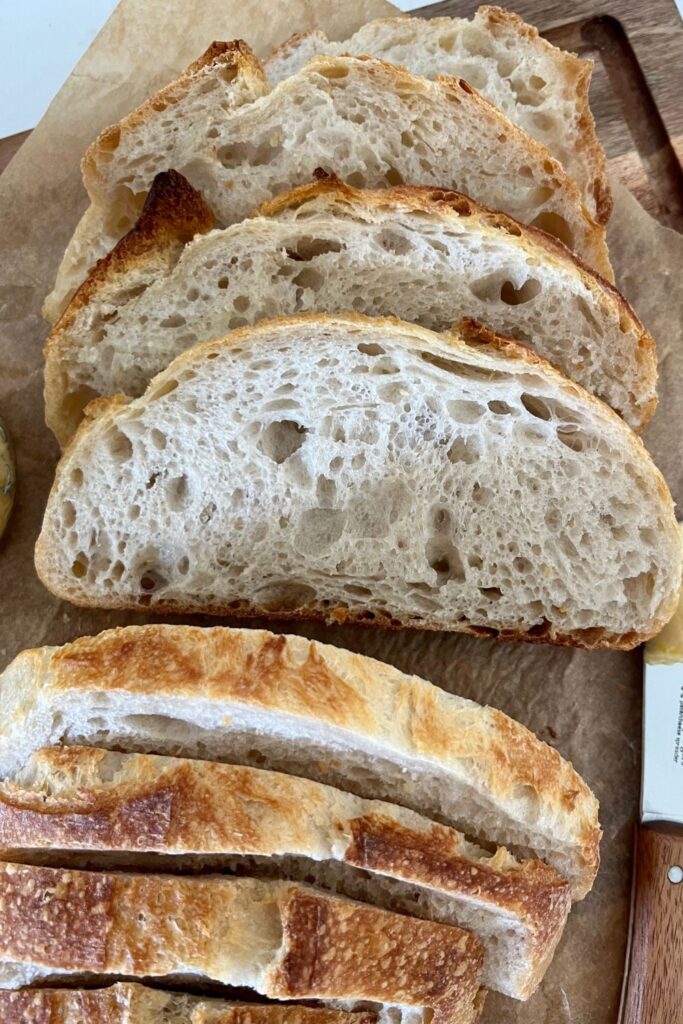
If you love making things that are a bit smaller, you might also enjoy making these other sourdough bread recipes - sourdough bread bowls, sourdough mini boules, a small batch of no wait sourdough waffles or even reducing the size of your starter to this smaller sourdough starter.
If you're looking to improve your sourdough journey, you might find these resources useful:
- How to make your own sourdough starter
- Is the float test even necessary?
- How to know when bulk fermentation has finished
- Alternatives to parchment paper for sourdough bread baking
- Where does the yeast in sourdough starter even come from?
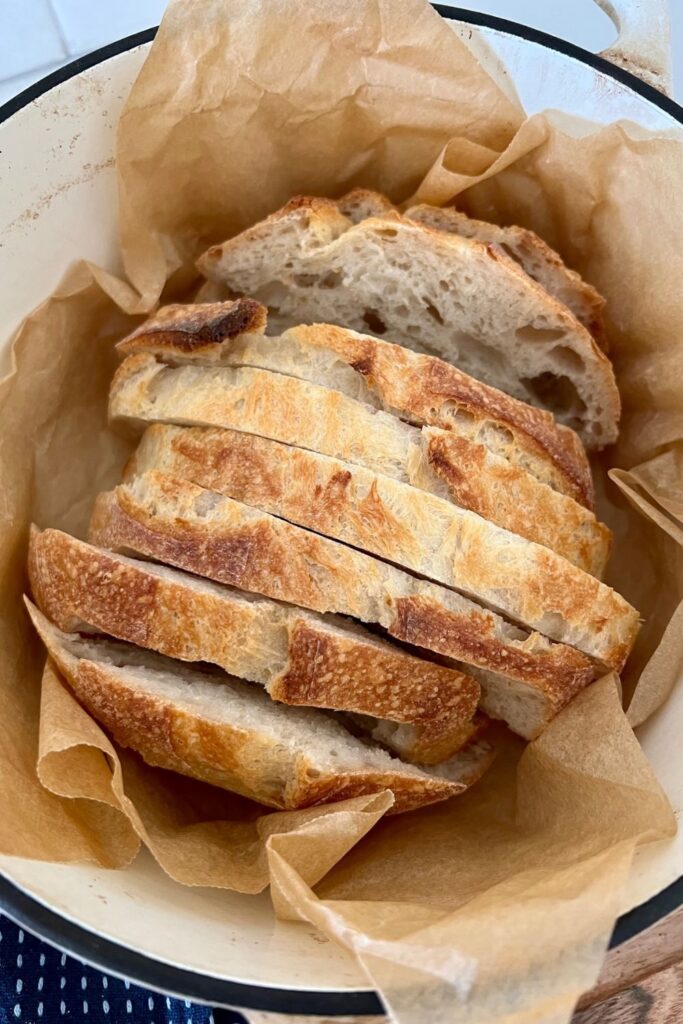
Why Make A Smaller Loaf of Sourdough Bread?
There are lots of reasons you might prefer making smaller loaves of sourdough bread. If you've made larger loaves before, you'll know each loaf takes around 500g of flour. This can be a lot of flour to waste if it doesn't turn out or even if it doesn't all get eaten.
Some of the reasons you might want to make a smaller loaf of sourdough bread with just 250 g flour are:
- Not using (wasting) so much flour on one loaf,
- Making just enough for 1 or 2 people to eat in a day or two with no waste,
- Wanting to use more expensive flour,
- Wanting to make more loaves to practice shaping and scoring techniques,
- Making a more "kid friendly" sized loaf for getting the kids involved in sourdough baking
- Making a loaf that fits in a smaller Dutch Oven or banneton that you already own.
These small sourdough loaves also make the perfect sourdough bread bowls! Fill them with your favorite soup or stew for a hearty meal.
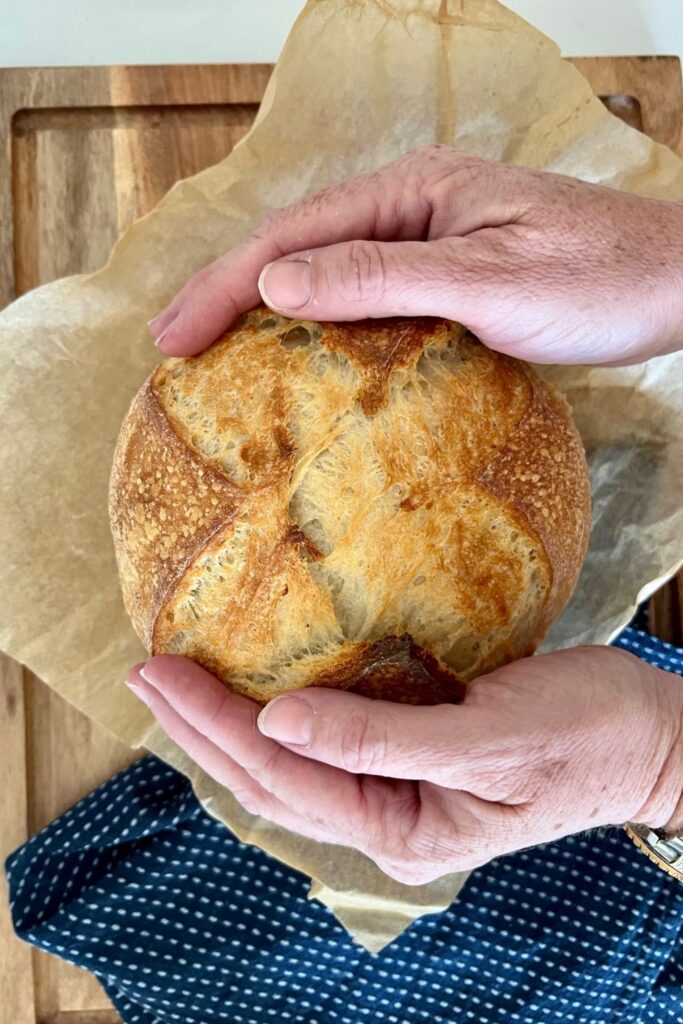
Can I Keep A Smaller Sourdough Starter?
I recommend keeping a sourdough starter that's around 50g (which you feed with 50g of flour and 50g of water), however if this is too much for your baking needs or you just want to use less flour, then you can keep a smaller sourdough starter. As long as you stick to the 1:1:1 ratio, you can maintain a small sourdough starter of around 25g or even less if you'd prefer. Keeping smaller quantities of starter creates less sourdough discard too.
A smaller amount of starter can be a good option if you're trying to pare back your sourdough routine, use less flour or you simply don't bake that often. The great thing about cultivating wild yeast is that you can increase the size of your starter whenever you need to.
The smallest amount of sourdough starter you can keep is around 5 to 10g, although it's up to you whether you keep this in liquid form in the fridge or dried in the pantry.
How To Make Small Batch Sourdough Bread
Making this small loaf of sourdough bread follows the same process as my simple sourdough loaf, just on a smaller scale.
Autolyse - Premixing The Dough
- Weigh out your wet ingredients (active sourdough starter and water) into a large mixing bowl - whatever you have in the cupboard is fine!
- Mix the water and starter together briefly. Then add your dry ingredients f(lour and salt) and mix whole lot together until a shaggy dough forms.
- Cover your bowl with a damp tea towel and let it sit for around 1 hour. It's ok if it's a little bit longer, it's not going to matter too much. This process is called the "autolyse" and allows your flour to soak in all the water and become hydrated.
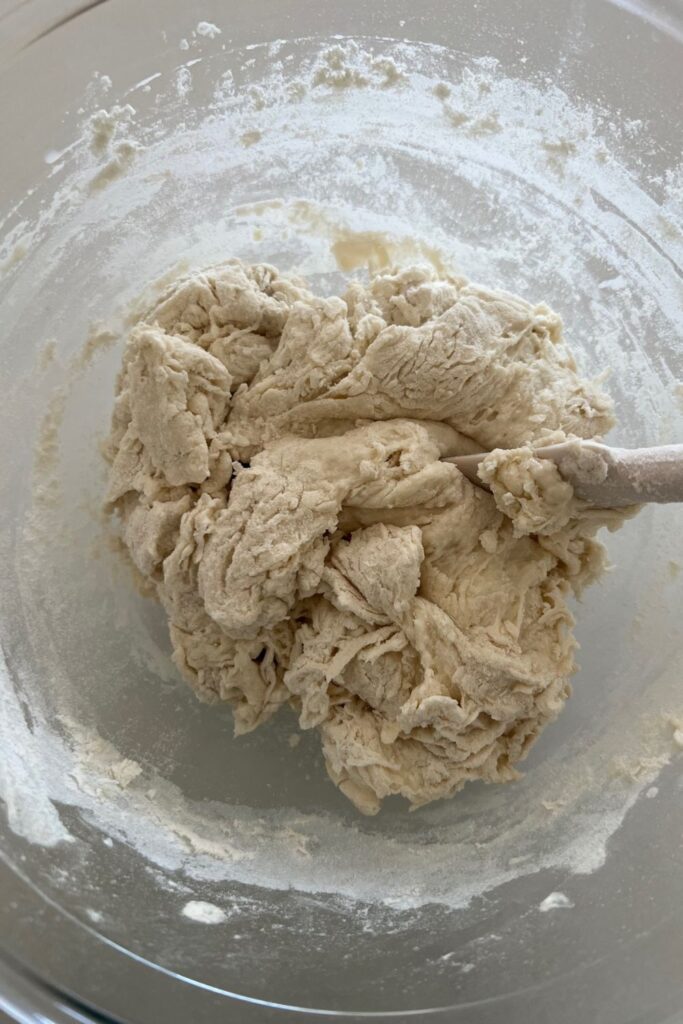
Forming Up The Dough
- After the dough has been through autolyse you need to bring it together into a ball. Work your way around the bowl, grabbing the dough from the outside, stretching it up and over itself, into the centre, until a smooth ball is formed. You shouldn't need more than about 20-25 stretches to form the ball.
- You'll notice that the dough is fully hydrated after soaking all the water up. It will be fairly sticky but as you bring it into a ball, it will become smoother and shinier.
- Once the dough has formed into a smooth ball, pop the damp tea towel back on and let it rest for 30 minutes.
Stretch & Fold - Creating Structure
- Over the next few hours you need to create some structure for your dough by "stretching and folding".
- Aim to do around 4-6 sets of stretches and folds.
- For each set, stretch the dough up and over itself 4 times. Leave around 15 minutes in between each set. Again you do not have to be exact with time, but you need to do at least 4 sets over 2 hours.
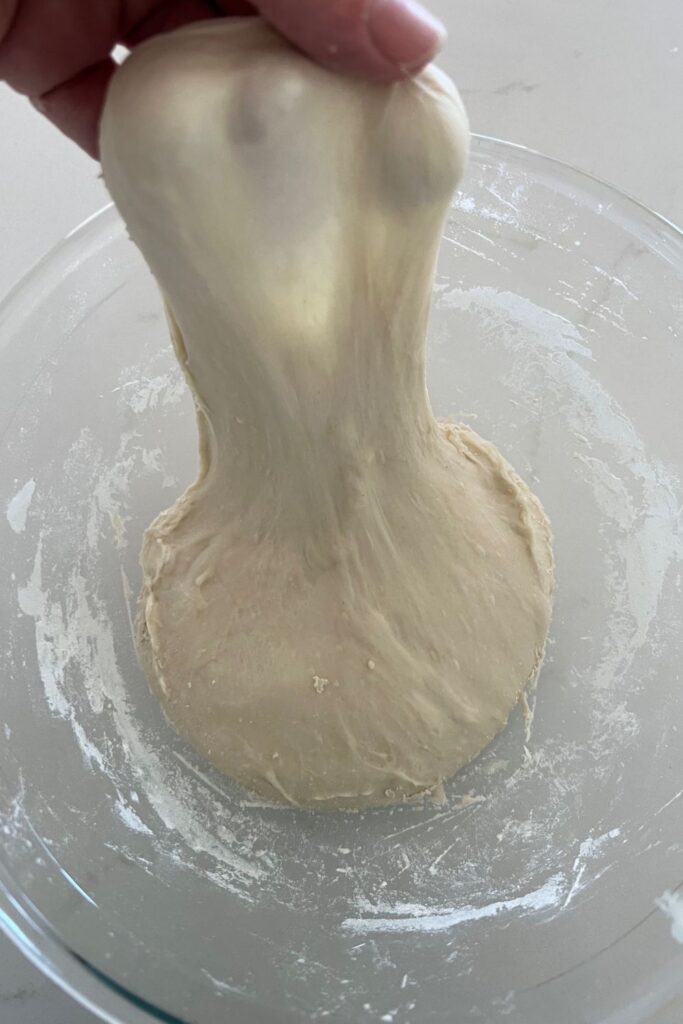
Bulk Ferment
- Once you've finished your stretch and folds, cover the dough with a plastic cover (a recycled plastic bag is perfect) and allow the dough to double (bulk fermentation).
Shaping The Dough
- Once your dough has finished its first ferment, it's time to shape it into either a boule or a batard.
- You'll need to flour your counter top with rice flour for this (we use rice flour because it has no gluten).
- Use a dough scraper to gently ease the dough out of the bowl (your hands work just fine if you don't have one). You want it to land upside down on your counter so that the smooth top of the dough is on the countertop and the sticky underside is facing up. This will make it easier to shape.
- You want to pull the edges of the dough into the centre and then flip it over so that the sticky side is now underneath. Using the stickiness, gently pull the dough into a tight ball.
- You will need a proofing basket or container to put your dough into. If you do not have a banneton, then a bowl or basket lined with a floured tea towel is perfectly fine. Make sure your bowl isn't too big though, you want your dough to retain some shape. You can find more notes on what to use as a banneton here.
- Whatever you're using needs to be liberally floured with your rice flour. If you're using a cloth or tea towel, rub the flour into it to ensure it becomes non stick (see notes here for details on this).
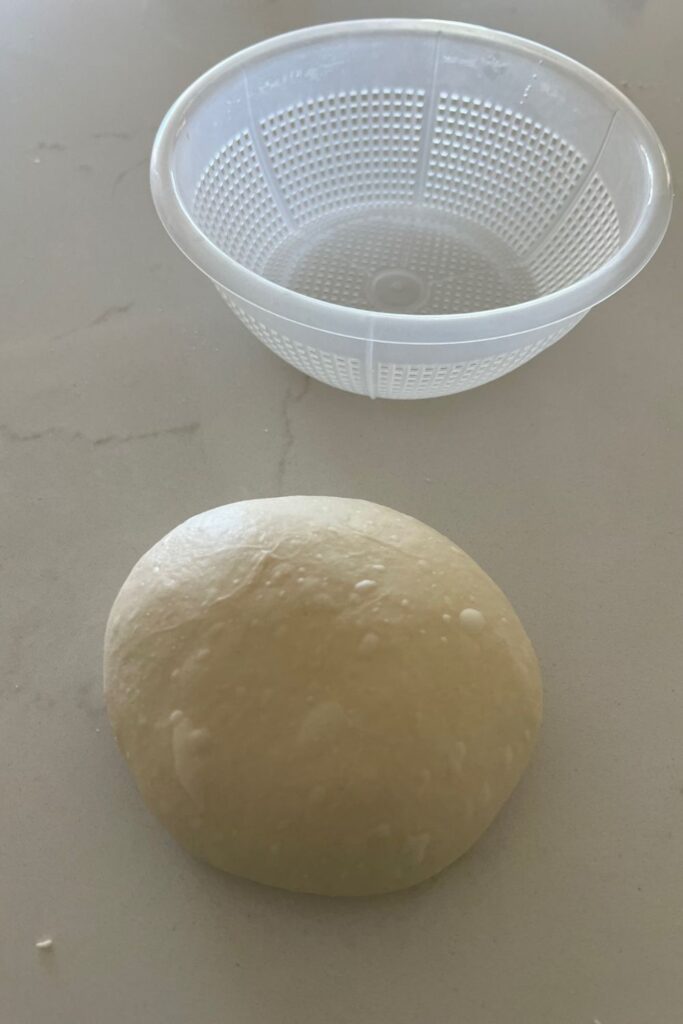
Placing Into A Banneton or Proofing Container
- Once the dough is shaped into a tight ball, place it into your proofing basket or container smooth side down, so your seam is on the top.
- If you're using a cloth or tea towel in a bowl it's ok to put your dough with the smooth side up. Just make sure the dough is tight.
- Lift your dough around the edges to pop a little more rice flour if you feel it needs it. Just try to handle the dough as little as possible and be really gentle as you really want to preserve all the gases and air bubbles that have formed during your bulk ferment.
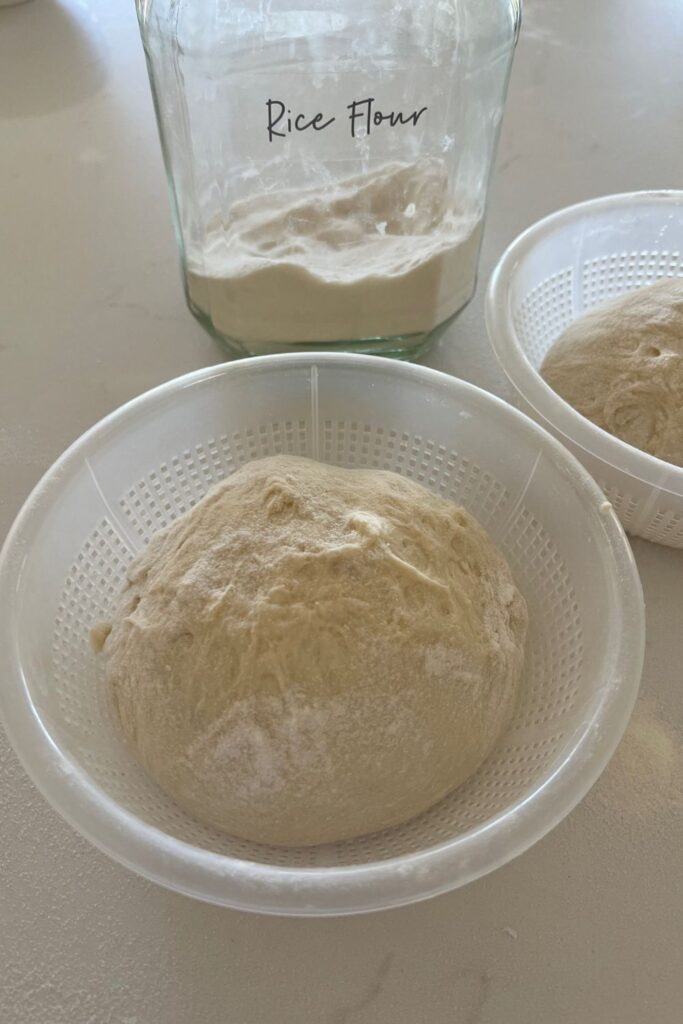
Cold Ferment
- Now the dough is in its "shaping container" cover it loosely with a plastic bag and place into the fridge. I use a large plastic bag to cover it - I just reuse it each time.
- Try to leave it in the fridge for a minimum 5 hours up to a maximum of around 36 hours. The longer you leave it the better your bread will be! A longer cold ferment creates beautiful blisters on your crust and a deeper sourdough flavour. It will also ensure your dough forms a skin which makes it easier to score.
Bake Your Small Batch Sourdough Loaf
- Once you're ready to bake your sourdough, you'll need to preheat your oven to 230C/450F.
- Place your Dutch Oven into the oven when you turn it on so it gets hot. Try to preheat for around 1 hour to ensure your oven is super hot - but you know your oven so just adjust this time if you need to.
- Leave your dough in the fridge until the very last minute - placing a cold dough into a hot oven will give you a great "spring".
- When your oven is at temperature, take your sourdough out of the fridge. Gently place it onto a piece of parchment paper or silicone sling if using.
- Gently score your bread with a clean razor blade or knife. At minimum a large cross is sufficient, but you can get as artistic as you like. You can find my full guide on how to score sourdough bread here.
- Carefully take your dutch oven out of the oven. Place the sourdough into the pot using the silicone sling or parchment paper as a handle. Put the lid on and place into the hot oven.
- If you want to you can spritz your dough with extra water before you put the lid on.
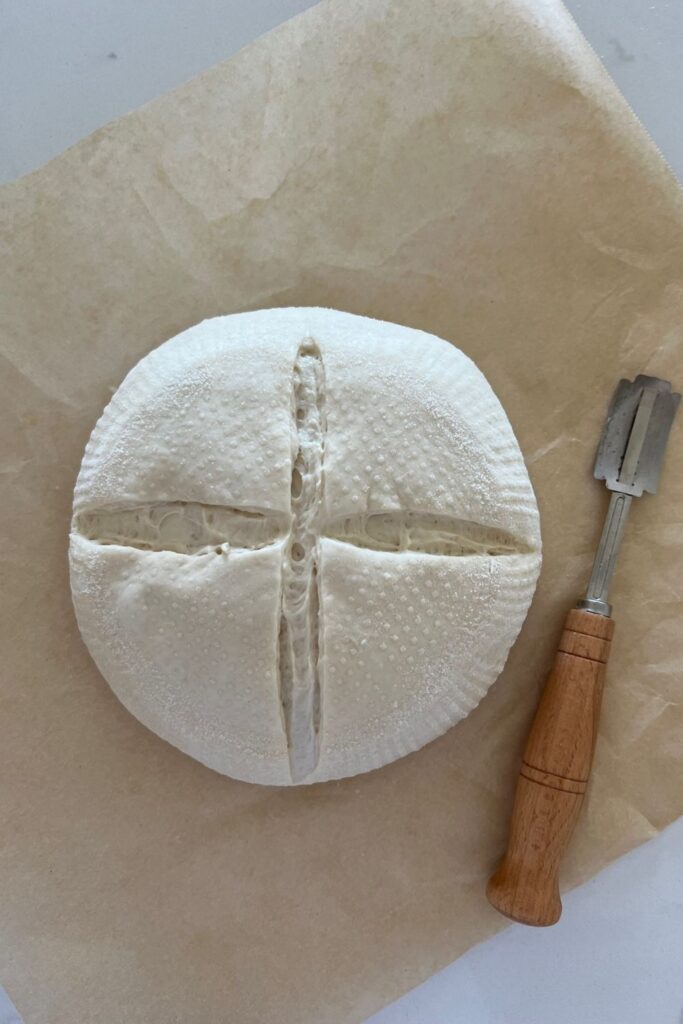
BAKE TIME:
30 Minutes with the lid on at 230C/450F plus
10-15 Minutes with the lid off at 210C/410F
Finishing The Bake
- When you remove your dough from the oven, carefully remove it from the oven as soon as possible and place on a wire rack to cool.
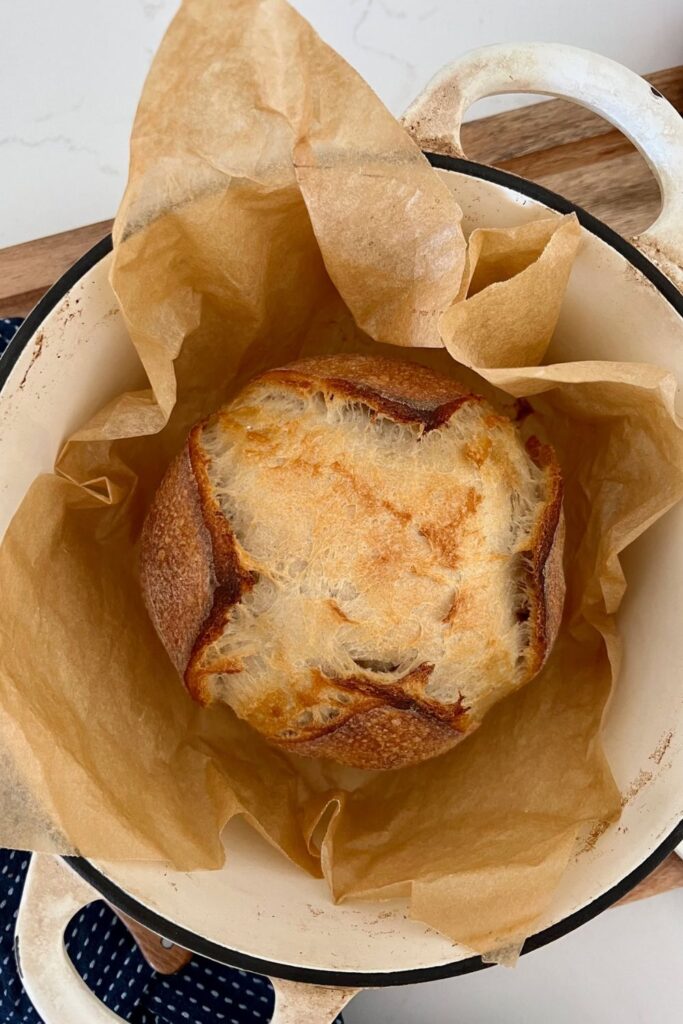
Best Tips for Small Batch Sourdough Bread
- Make sure your active starter has been fed in the last few hours and your starter is at it's peak when you mix your dough. Keeping your sourdough starter warm really helps with this.
- A kitchen scale is a great investment to ensure you're baking with accuracy and consistency each time.
- Map out a sourdough baking timeline before you start so that you're not having to stay up late doing stretch and folds (unless you're a night owl of course).
- Keep an eye on the ambient temperature in your kitchen - remember the sourdough fermentation process happens at warmer temperatures rather than colder temperatures.
- Bake your smaller loaves in a hot Dutch Oven for the best results. I've used a 3.1L or 3.2Q Dutch Oven. Use these tips for baking sourdough without a Dutch Oven. This size loaf is also perfect to bake in a toaster oven.
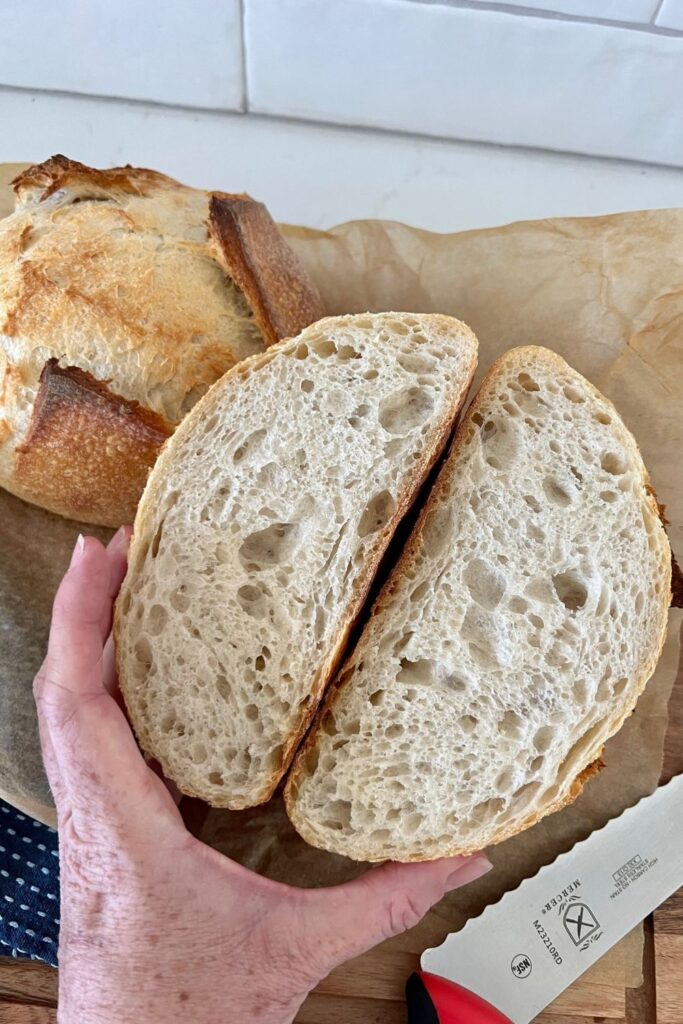
Do Smaller Sourdough Loaves Take Less Time To Bake?
Not necessarily. The small batch sourdough bread in this recipe is baked for the same amount of time as a loaf with 500g of flour. Reducing the weight of the loaf doesn't not necessarily mean you bake it for less time.
Sometimes you will need to experiment with baking time, but for the most part, you can leave it the same. Sometimes, the lid off baking time will be less because with less surface area, the smaller loaves take less time to brown. But for the most part, lid on bake time will be the same.
Can You Add Whole Wheat Flour To This Recipe?
If you prefer using whole grain flours, you can substitute up to half of the bread flour with whole wheat flour or rye flour.
Just remember that whole wheat flour, as well as rye flour can decrease the oven spring you get, as well as give you a more dense crumb. Using Vital Wheat Gluten can help with this issue.
Best Bannetons for Small Batch Sourdough Loaf
When using only 250g of flour, the resulting loaf will be too small to use a "regular" sized banneton. Instead of buying new bannetons for making smaller sized sourdough loaves, I find it easier to use what I have on hand.
Often you can use a soup or cereal bowl quite well, but I have found the best thing to use are ricotta cheese baskets from 500g packages of ricotta cheese.
They are the perfect size for holding these small batch sourdough loaves. I dust the dough with rice flour before flipping it into the banneton and have no issues with the dough sticking. However if you're worried you can use a rice floured cloth inside the basket.
You can find more alternatives for proofing baskets here.
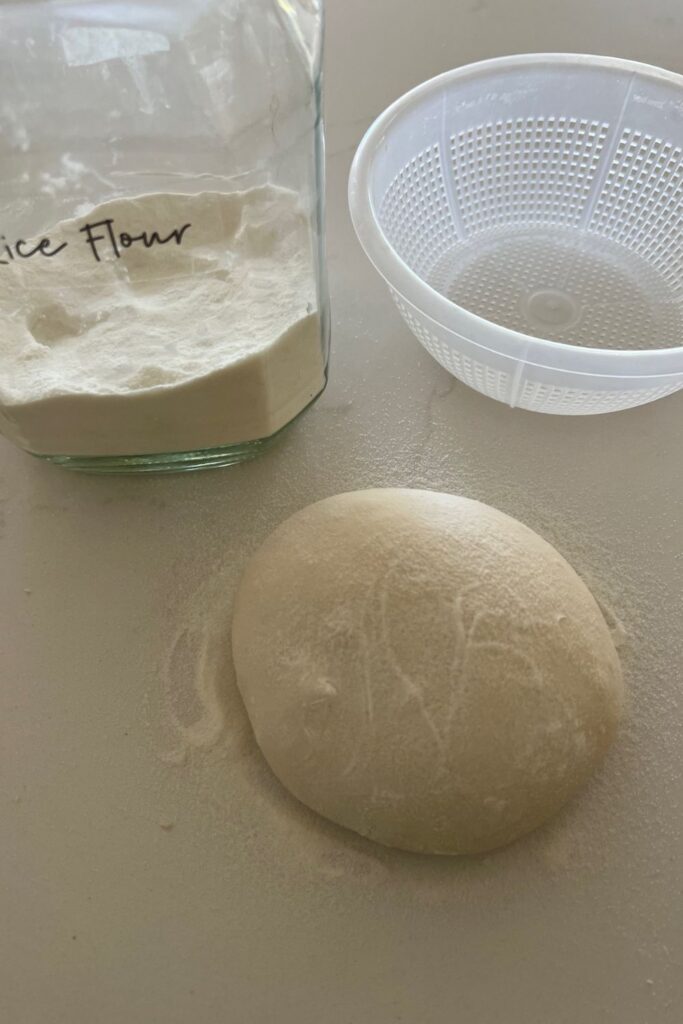
Frequently Asked Questions
Yes you can easily halve a sourdough bread recipe using baker's percentages or baker's math, so long as the recipe is written in grams.
A sourdough loaf made with 250g of flour is the perfect size for a sourdough bread bowl. You can use the small batch sourdough bread recipe above to make them. Just multiply the recipe by however many bread bowls your need.
You don't necessarily need to adjust the cooking time when you halve a sourdough recipe. Generally the same cooking time will apply, whether you're using 500g of flour or 250g of flour. You'll just need to keep an eye on the lid off time to ensure the loaf doesn't brown too quickly.
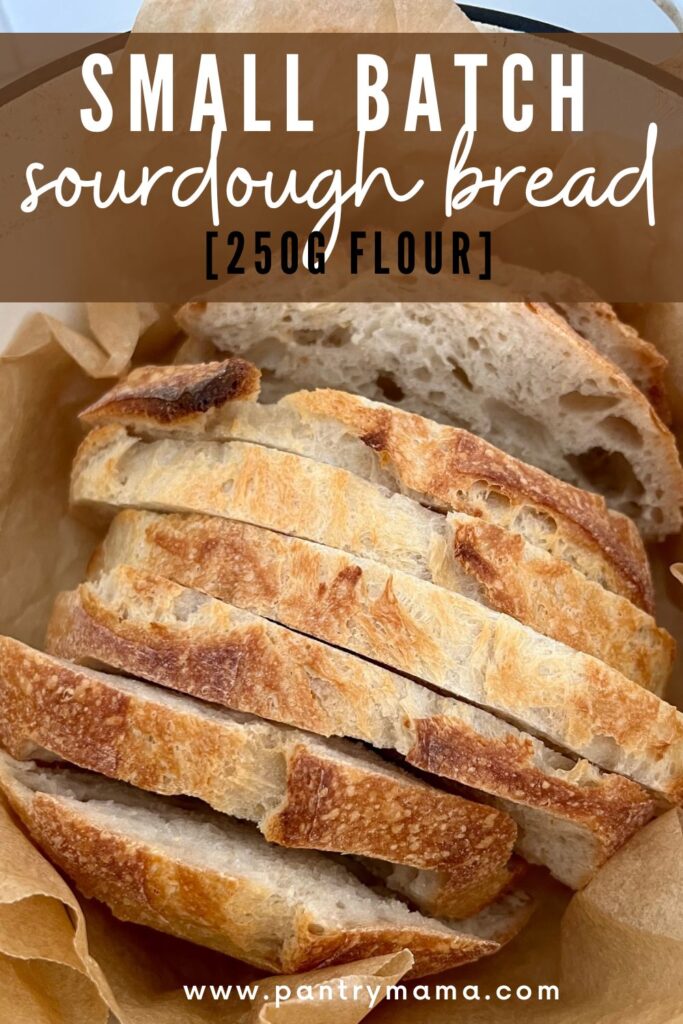
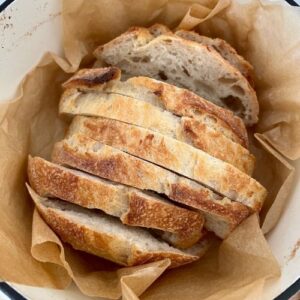
Small Batch Sourdough Bread
Equipment
- Basic Kitchen Scale (grab them for as little as $10 here)
Ingredients
- 250 g Bread Flour
- 175 g Water
- 50 g Sourdough Starter (Fed and Bubbly)
- 5 g Salt (increase or decrease according to your taste)
Instructions
- Autolyse - Premixing The DoughWeigh out your sourdough starter and water into a large mixing bowl - whatever you have in the cupboard is fine!Glass is always good as you can see what's happening underneath your dough. But any plastic, ceramic, stainless steel or glass bowl is fine! Mix the water and starter together briefly. Then add your flour and salt and mix whole lot together to form a shaggy dough. The dough will be fairly shaggy and only just brought together (see photo). You might wonder how this will turn into bread, but just wait, time is your friend and the dough will change in around an hour.
- Cover your bowl with a damp tea towel and let it sit for around 1 hour. It's ok if it's a little bit longer, it's not going to matter too much.This process is called the "autolyse" and allows your flour to soak in all the water and become hydrated.
- Forming Up The DoughAfter the dough has been through autolyse you need to bring it together into a ball. Work your way around the bowl, grabbing the dough from the outside, stretching it up and over itself, into the centre, until a smooth ball is formed. You shouldn't need more than about 20-25 stretches to form the ball.You'll notice that the dough is fully hydrated after soaking all the water up. It will be fairly sticky but as you bring it into a ball, it will become smoother and shinier.
- Once the dough has formed into a smooth ball, pop the damp tea towel back on and let it rest for 30 minutes.
- Stretch & Fold - Creating StructureOver the next few hours you need to create some structure for your dough by "stretching and folding". Aim to do around 4-6 sets of stretches and folds. For each set, stretch the dough up and over itself 4 times. Leave around 15 minutes in between each set. Again you do not have to be exact with time, but you need to do at least 4 sets over 2 hours.I like to be fairly liberal with my timings as I am generally cooking amongst the chaos of family life and therefore sometimes timing does go astray!
- Bulk FermentOnce you've finished your stretch and folds, cover the dough with a plastic cover (a recycled plastic bag is perfect) and allow the dough to double (bulk fermentation).See notes below for more info on this step.
- Shaping The DoughOnce your dough has finished its first ferment, it's time to shape it into either a boule or a batard. You'll need to flour your counter top with rice flour for this (we use rice flour because it has no gluten). Try to be quite sparing with the rice flour, you only need a very light dusting.Use a dough scraper to gently ease the dough out of the bowl (your hands work just fine if you don't have one). You want it to land upside down on your counter so that the smooth top of the dough is on the countertop and the sticky underside is facing up. This will make it easier to shape.You want to pull the edges of the dough into the centre and then flip it over so that the sticky side is now underneath. Using the stickiness, gently pull the dough into a tight ball.You will need a proofing basket or container to put your dough into. If you do not have a banneton, then a bowl or basket lined with a floured tea towel is perfectly fine. Make sure your bowl isn't too big though, you want your dough to retain some shape. You can find more notes on what to use as a banneton here.Whatever you're using needs to be liberally floured with your rice flour. If you're using a cloth or tea towel, rub the flour into it to ensure it becomes non stick (see notes here for details on this).
- Placing Into A Proofing ContainerOnce the dough is shaped into a tight ball, place it into your proofing basket or container smooth side down, so your seam is on the top.If you're using a cloth or tea towel in a bowl it's ok to put your dough with the smooth side up. Just make sure the dough is tight.Lift your dough around the edges to pop a little more rice flour if you feel it needs it. Just try to handle the dough as little as possible and be really gentle as you really want to preserve all the gases and air bubbles that have formed during your bulk ferment.
- Cold FermentNow the dough is in its "shaping container" cover it loosely with a plastic bag and place into the fridge. I use a large plastic bag to cover it - I just reuse it each time. Try to leave it in the fridge for a minimum 5 hours up to a maximum of around 36 hours. The longer you leave it the better your bread will be! A longer cold ferment creates beautiful blisters on your crust and a deeper sourdough flavour. It will also ensure your dough forms a skin which makes it easier to score.
BAKE YOUR SMALL BATCH SOURDOUGH LOAF
- Once you're ready to bake your sourdough, you'll need to preheat your oven to 230C/450F. Place your Dutch Oven into the oven when you turn it on so it gets hot. Try to preheat for around 1 hour to ensure your oven is super hot - but you know your oven so just adjust this time if you need to.Leave your dough in the fridge until the very last minute - placing a cold dough into a hot oven will give you a great "spring".When your oven is at temperature, take your sourdough out of the fridge. Gently place it onto a piece of parchment paper or silicone sling if using. Gently score your bread with a clean razor blade or knife. At minimum a large cross is sufficient, but you can get as artistic as you like. You can find my full guide on how to score sourdough bread here.Carefully take your dutch oven out of the oven. Place the sourdough into the pot using the silicone sling or parchment paper as a handle. Put the lid on and place into the hot oven. If you want to you can spritz your dough with extra water before you put the lid on.BAKE TIME:30 Minutes with the lid on at 230C/450F plus10-15 Minutes with the lid off at 210C/410F
- Finishing The BakeWhen you remove your dough from the oven, carefully remove it from the oven as soon as possible and place on a wire rack to cool.
Notes
- Notes on Flour: This recipe is written using strong Bread Flour. Bread flour has a higher protein content than All Purpose flour. If you choose to use All Purpose flour you may have a different result because of this. You can read more about the differences between All Purpose Flour and Bread Flour here.
- Notes on Sourdough Starter: This recipe is based on you having an active starter that you have fed a few hours before starting your bake. For info on how to make a sourdough starter, go here.
- Notes on Stretch & Folds: If you are going to do the stretch & folds on your bench top, spray your surface with water mist rather than using flour. You can leave the dough in the bowl if you want to. Wet your hands to stop the dough sticking - although it shouldn't be too sticky. It will get less sticky as you do your stretches and folds. For more information on how to do stretch and folds, go here.
- Notes on Bulk Fermentation: If your home is warm then your dough will ferment a lot faster and could be done in as little as a few hours. If it's colder, it will take longer, possibly overnight.
I would recommend that you try to do your first few bulk ferments during daylight hours so that you can watch your dough closely.
Once you're more familiar with the process - and the temperature of your home - you will be able to do overnight ferments. You will know your dough is ready to move to the next stage when it has *just* doubled in size. It will be fairly wobbly and full of bubbles. You should be able to see large air bubbles under the surface of the dough.
You don't want to let it go any further than doubled as it will be over fermented.
If you want to do an overnight ferment, but your home is warm, consider using a little less starter (ie 25g).
Less starter means your dough will take longer to ferment and you will reduce the risk of over fermenting your dough. You'll find more information on these topics here:
When is my bulk ferment finished? What is the difference between cold ferment and bulk ferment? Why does the amount of starter matter?
- Notes on Baking: If you're worried about the base of your bread burning, place a baking sheet on shelf underneath your Dutch Oven - it works! If you're worried about your bread not being cooked all the way through, turn the oven off and place your dough straight onto the oven rack. Leave the door ajar and let your bread rest there for a few hours. Make sure you don't close the door or your sourdough will sweat and you'll get a wrinkly, soggy crust. Remember not to cut into your loaf too soon - you'll need to let it cool for at least a few hours (4-6 is best).


